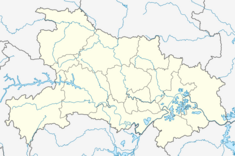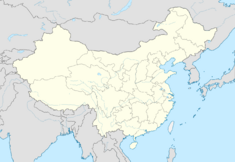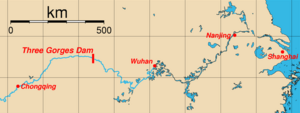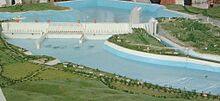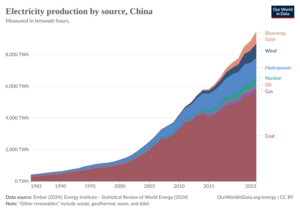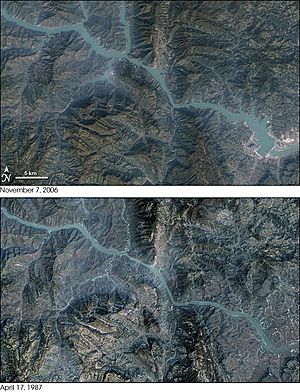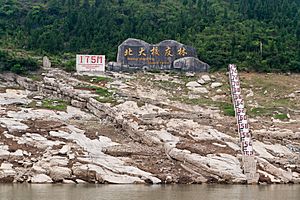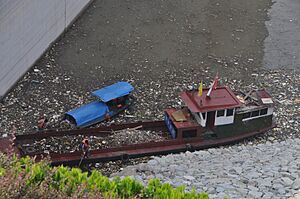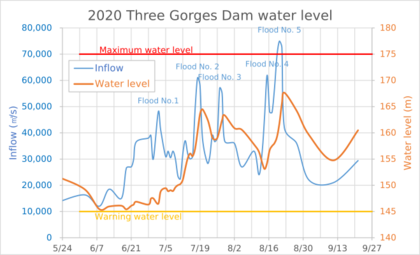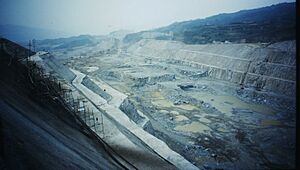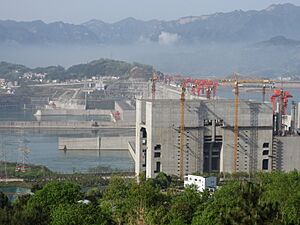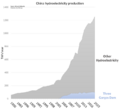Three Gorges Dam facts for kids
Quick facts for kids Three Gorges Dam三峡大坝 |
|
|---|---|

The dam in September 2009
|
|
|
Location in Hubei Province
|
|
| Country | China |
| Location | Sandouping, Yiling District, Hubei |
| Coordinates | 30°49′23″N 111°00′12″E / 30.82306°N 111.00333°E |
| Purpose | Flood control, power, navigation |
| Status | Operational |
| Construction began | December 14, 1994 |
| Opening date | 2003 |
| Construction cost | ¥203 billion (US$31.765 billion) |
| Owner(s) | China Yangtze Power (subsidiary of China Three Gorges Corporation) |
| Dam and spillways | |
| Type of dam | Gravity dam |
| Impounds | Yangtze River |
| Height | 181 m (594 ft) |
| Length | 2,335 m (7,661 ft) |
| Width (crest) | 40 m (131 ft) |
| Width (base) | 115 m (377 ft) |
| Dam volume | 27.2 million m3 (35.6 million cu yd) |
| Spillway capacity | 116,000 m3/s (4,100,000 cu ft/s) |
| Reservoir | |
| Creates | Three Gorges Reservoir |
| Total capacity | 39.3 km3 (31,900,000 acre⋅ft) |
| Catchment area | 1,000,000 km2 (390,000 sq mi) |
| Surface area | 1,084 km2 (419 sq mi) |
| Maximum length | 600 km (370 mi) |
| Normal elevation | 175 m (574 ft) |
| Power station | |
| Commission date | 2003–2012 |
| Type | Conventional |
| Hydraulic head | Rated: 80.6 m (264 ft) Maximum: 113 m (371 ft) |
| Turbines | 32 × 700 MW 2 × 50 MW Francis-type |
| Installed capacity | 22,500 MW |
| Capacity factor | 45% |
| Annual generation | 101.6 TWh (366 PJ) (2018) |
The Three Gorges Dam (simplified Chinese: 三峡大坝; traditional Chinese: 三峽大壩; pinyin: Sānxiá Dàbà) is a giant hydroelectric dam in China. It stretches across the Yangtze River in Hubei province. This dam is the world's largest power station based on how much electricity it can make.
The Three Gorges Dam helps control floods, makes electricity, and improves shipping on the Yangtze River. It protects millions of people from severe flooding. The dam's power also helps China's economy grow. Many in China see it as a symbol of national success. However, building the dam also caused many people to move and changed the environment.
The main part of the dam was finished in 2006. Its power plant started working fully in 2012. The last big part, a special ship lift, was done in 2015. The dam is 185 meters (607 feet) tall and 2,309 meters (7,575 feet) wide. It has 32 main turbines, each making 700 MW of power. Two smaller generators also help power the plant. In total, it can produce 22,500 MW of electricity.
| Three Gorges Dam | |||||||||||||
|---|---|---|---|---|---|---|---|---|---|---|---|---|---|
| Simplified Chinese | 三峡大坝 | ||||||||||||
| Traditional Chinese | 三峽大壩 | ||||||||||||
| Literal meaning | Three Gorges Great Dam | ||||||||||||
|
|||||||||||||
Contents
Building the Three Gorges Dam

The idea for a large dam on the Yangtze River goes back a long time. In 1919, Sun Yat-sen first suggested it. He thought a dam could make 22 gigawatts of power. Later, in 1932, the Chinese government started planning for it.
In 1944, an American engineer named John L. Savage looked at the area. He drew up a plan for the "Yangtze River Project." His plans included a unique way to move ships over the dam using cranes. But no construction happened because of war.
After 1949, Mao Zedong supported the dam project. However, economic problems and political changes slowed things down. After a big flood in 1954, Mao wrote a poem about his dream for a dam on the Yangtze. In 1958, some engineers who spoke against the project were put in prison.
The project was brought back in 1986. The government wanted to build it to create more hydroelectric power. But many people disagreed with the plan.
The National People's Congress finally approved the dam in 1992. However, it was not a unanimous vote. Construction began on December 14, 1994. The dam was expected to be fully ready by 2009. But extra parts, like underground generators, meant it wasn't fully working until 2012. The ship lift was finished in 2015.
Dam's Size and Structure
The Three Gorges Dam is built from concrete and steel. It is 2,335 meters (7,661 feet) long. The top of the dam is 185 meters (607 feet) above sea level.
Building the dam used a huge amount of materials. It took 27.2 million cubic meters (35.6 million cubic yards) of concrete. It also used 463,000 tonnes of steel, which is enough to build 63 Eiffel Towers. Workers also moved about 102.6 million cubic meters (134.2 million cubic yards) of earth. The concrete wall of the dam is 181 meters (594 feet) high from its base.
When the water in the reservoir is at its highest, it is 175 meters (574 feet) above sea level. This is 110 meters (361 feet) higher than the river below the dam. The reservoir is about 660 kilometers (410 miles) long and 1.12 kilometers (0.7 miles) wide on average. It holds 39.3 cubic kilometers (9.4 cubic miles) of water. The total surface area of the reservoir is 1,045 square kilometers (403 square miles).
Cost of the Dam
The Chinese government first thought the dam would cost about 180 billion yuan (US$22.5 billion). By the end of 2008, the cost had reached 148.365 billion yuan. A large part of this money, 68.557 billion yuan, was spent on moving people who lived in the area.
It was estimated that the dam would pay for itself after generating 1,000 TWh of electricity. This would bring in 250 billion yuan. The dam's full cost was actually recovered by December 20, 2013.
Money for the dam came from different sources. These included a special fund, profits from another dam, and loans from banks. Provinces that received power from the dam also paid an extra fee on their electricity.
How the Dam Makes Power
Power Generation
The Three Gorges Dam is the world's largest hydroelectric power station. It has 34 generators. There are 32 main generators, each making 700 MW of power. Two smaller generators, each 50 MW, power the plant itself. This gives the dam a total power capacity of 22,500 MW. In 2018, it produced 101.6 TWh of electricity. This is 20 times more than the Hoover Dam.
How Generators Work
Each main generator weighs about 6,000 tonnes. They are designed to produce over 700 MW of power. The water falls from a height of about 80.6 meters (264 feet) to spin the turbines. The amount of water needed changes depending on the water level. The higher the water level, the less water is needed to make full power.
The dam uses Francis turbines. These turbines are very large, about 9.7 to 10.4 meters (32 to 34 feet) in diameter. They spin at 75 revolutions per minute. The electricity is produced at 20 kilovolts (kV) and then increased to 500 kV for sending out to cities. The generators are very efficient, working at over 94% efficiency.
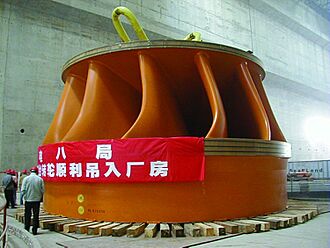
Companies from different countries worked together to make these generators. These included Alstom, ABB, Kvaerner, Voith, General Electric, and Siemens. Most of the generators are cooled by water. Some newer ones are cooled by air, which makes them simpler to build and maintain.
When Generators Started Working
The first main generator started working on July 10, 2003. All the generators on the north side were working by September 7, 2005. The dam reached its full power of 9,800 MW on October 18, 2006.
On the south side, generators started working from June 2007 to October 2008. By December 2007, the dam's capacity was 14.1 GW. This made it the world's largest hydropower plant at that time.
The last main generator started its tests on May 23, 2012. This meant all six underground generators were working. The entire power plant was fully operational by July 2012.
How Much Power is Made Each Year
| Year | Number of installed units |
TWh | Reference |
|---|---|---|---|
| 2003 | 6 | 8.607 | |
| 2004 | 11 | 39.155 | |
| 2005 | 14 | 49.090 | |
| 2006 | 14 | 49.250 | |
| 2007 | 21 | 61.600 | |
| 2008 | 26 | 80.812 | |
| 2009 | 26 | 79.470 | |
| 2010 | 26 | 84.370 | |
| 2011 | 29 | 78.290 | |
| 2012 | 32 | 98.100 | |
| 2013 | 32 | 83.270 | |
| 2014 | 32 | 98.800 | |
| 2015 | 32 | 87.000 | |
| 2016 | 32 | 93.500 | |
| 2017 | 32 | 97.600 | |
| 2018 | 32 | 101.600 | |
| 2019 | 32 | 96.880 | |
| 2020 | 32 | 111.800 | |
| 2021 | 32 | 103.649 | |
| 2022 | 32 | 78.790 | |
| 2023 | 32 | 80.271 | |
| 2024 | 32 | 82.911 |
By August 16, 2011, the dam had made 500 TWh of electricity. In July 2008, it made over 10 TWh in one month for the first time. During a flood in August 2009, the plant reached its highest power output for a short time.
During the dry season (November to May), the amount of power made is limited by how much water flows in the river. When there is enough water, the power output is limited by the plant's capacity.
The Three Gorges Dam reached its highest water level of 175 meters (574 feet) on October 26, 2010. In 2012, the dam's generators made a record 98.1 TWh of electricity. This was 14% of all the hydroelectric power made in China that year. Between 2012 and 2021, the dam made an average of 97.22 TWh of electricity each year. In 2020, because of heavy monsoon rains, it produced about 112 TWh. This broke the world record for annual production.
Sending Power Out
The electricity from the dam is sent to different parts of China. Nine provinces and two cities use power from the dam. The cost to build the power lines and other equipment was about 34.387 billion yuan. This work was finished in December 2007.
The dam was expected to provide 10% of China's power. But China's need for electricity grew very fast. So, even with its huge size, the dam only supplied about 1.7% of China's electricity in 2011.
Impact on the Environment
Erosion and Sediment
One concern about the dam is how it affects the river's sediment. Sediment is like dirt and sand carried by the river. About 80% of the land in the dam area is eroding, sending 40 million tons of sediment into the Yangtze each year. Because the water flows slower above the dam, much of this sediment settles there. Less sediment flows downstream.
This lack of sediment downstream can cause problems:
- Riverbanks downstream might become more likely to flood.
- The city of Shanghai, which is far away, is built on a large plain of sediment. Less sediment reaching it could make the city more vulnerable to floods.
- Sediment building up on the riverbed can harm plants and animals in the water.
Landslides
The rising water in the reservoir causes erosion. This leads to frequent landslides. In May 2009, two large landslides happened in the Wuxia Gorge. In the first four months of 2010, there were 97 major landslides.
Waste Management
The dam project led to better wastewater treatment upstream, especially around the city of Chongqing. By April 2007, over 50 new plants could treat 1.84 million tonnes of wastewater daily. About 32 new landfills were also built. However, over one billion tons of wastewater still go into the river each year. Before the dam, this waste was swept away. Now, the water can become still, polluted, and murky.
Forest Cover
In 1997, only 10% of the Three Gorges area was covered by forests. This was down from 20% in the 1950s. China has since started a big effort to replant trees. This increased after the 1998 Yangtze River floods. The government realized that more trees were needed to help control floods, especially upstream of the dam.
Wildlife and Biodiversity
The dam's impact on wildlife was a concern even before it was approved. This area is known for its many different kinds of plants and animals. It has 6,388 plant species, and 57 of them are endangered. Many of these rare plants are used in traditional Chinese medicines. The loss of forest cover has harmed all plant species there.
The region is also home to many freshwater and land animals. Fish are especially affected by dams because the water temperature and flow change. Many fish are also hurt by the turbines. The Yangtze River basin has 361 different fish species. It is home to 27% of China's endangered freshwater fish. Other water animals have also been endangered. The baiji, or Chinese river dolphin, is now extinct. Some Chinese scholars even say the Three Gorges Dam directly caused its extinction.
Many critically endangered Siberian cranes spend winter in wetlands that the dam will affect. The dam will also negatively affect populations of the Yangtze sturgeon. In 2022, the Chinese paddlefish was declared extinct. Its last confirmed sighting was in 2003.
Impact on Earth
In 2005, scientists calculated that the huge amount of water stored by the dam would slightly change the Earth's rotation. It would make the Earth's day longer by 0.06 microseconds. It would also make the Earth a tiny bit more round in the middle and flatter at the poles. A 2022 study suggested that the changing water level in the reservoir affects gravity in western Sichuan. This, in turn, affects earthquakes in that area. {{wide image|200407-sandouping-sanxiadaba-4.med.jpg|800px|A wide view of the Three Gorges Dam.]]
Flood Control and Water Use
One very important job of the dam is to control floods. Flooding is a big problem for the Yangtze River, which has strong seasonal flows. Millions of people and important cities like Wuhan, Nanjing, and Shanghai are located downstream. Large areas of farmland and China's main industrial areas are also along the river.
The dam's reservoir can hold 22 cubic kilometers (5.3 cubic miles) of floodwater. This helps reduce major downstream flooding from happening every 10 years to only once every 100 years. The dam is also expected to help with "super" floods. For example, the 1954 flood covered 193,000 square kilometers (74,518 square miles) and killed 33,169 people. The dam could help prevent such disasters.
In August 2009, the biggest flood in five years passed through the dam. The dam limited the water flow downstream. It captured 4.27 cubic kilometers (1.02 cubic miles) of floodwater. This greatly reduced the river flow below the dam.
The dam releases water from its reservoir during the dry season, from December to March. This increases the river's flow downstream. It provides fresh water for farms and industries. It also makes shipping conditions better. The water level upstream drops from 175 meters (574 feet) to 145 meters (476 feet) to get ready for the rainy season.
Since 2003, the Three Gorges Dam has provided an extra 11 cubic kilometers (2.6 cubic miles) of fresh water to cities and farms downstream during the dry season.
During the 2010 China floods in July 2010, water flowing into the Three Gorges Dam was very high. The dam's reservoir rose almost 3 meters (10 feet) in 24 hours. But the dam reduced the water released downstream, preventing major problems in the middle and lower parts of the river.
Moving Around the Dam
Ship Locks
Special ship locks were built near the dam (30°50′12″N 111°1′10″E / 30.83667°N 111.01944°E). These locks help ships move past the dam. They are expected to increase river shipping from 10 million to 100 million tonnes each year. This will also cut transportation costs by 30% to 37%. Shipping will also become safer, as the gorges were known to be dangerous to navigate.
There are two sets of ship locks, each with five steps. It takes about four hours for a ship to go through them. The largest ships that can use the locks are 10,000 tons. Each lock is 280 meters (918 feet) long, 35 meters (114 feet) wide, and 5 meters (16.4 feet) deep. Before the dam, the river could handle 18 million tonnes of freight per year. From 2004 to 2007, 198 million tonnes of freight passed through the locks. The river's shipping capacity increased six times. In 2022, the locks handled 159.65 million tons of cargo.
These locks are like a staircase for ships. Inner gates serve as both the top gate for the chamber below and the bottom gate for the chamber above. There are separate sets of locks for ships going upstream and downstream. This design saves water.
Ship Lift
Besides the locks, there is also a ship lift. This is like a giant elevator for boats. It can lift ships up to 3,000 tons. The lift moves ships up or down 113 meters (371 feet). The ship lift's basin is 120 meters (394 feet) long, 18 meters (59 feet) wide, and 3.5 meters (11.5 feet) deep.
Using the ship lift takes only 30 to 40 minutes. This is much faster than the three to four hours it takes to go through the locks. The ship lift needs to work even when water levels change a lot.
The ship lift was not finished when the rest of the dam officially opened in 2006. Construction started in October 2007. By February 2012, the four towers supporting the lift were almost done.
The ship lift was expected to be completed by July 2015. It was tested in December 2015 and announced complete in January 2016. The German company that designed it said it would take less than an hour to use. The actual lift time is 21 minutes. It can carry passenger vessels up to 3,000 tonnes. The moving part, including counterweights, weighs 34,000 tonnes.
Trials for the elevator finished in July 2016. The first cargo ship was lifted on July 15. The lift took only 8 minutes. On September 18, 2016, the lift began limited "operational testing."
People and Culture Around the Dam
Moving Residents
During the planning, it was thought that 13 cities, 140 towns, and 1,350 villages would be flooded by the reservoir. This meant about 1.5% of the people in Hubei and Chongqing would need to move. The Chinese government moved these people to new homes. They said this was necessary because the dam would protect communities downstream from floods.
Between 2002 and 2005, a Canadian photographer, Edward Burtynsky, took pictures of the changes the dam caused. Other photographers also documented the changes. For many, living conditions became harder, and hundreds of thousands struggled to find work. Older people were especially affected. However, younger people sometimes found new opportunities in bigger cities with modern jobs and schools.
By June 2008, China had moved 1.24 million residents. The moves were completed the following month.
Cultural and Historical Sites
The area that was flooded by the dam included many places with important cultural history. The government started a 505 million yuan effort to save archaeological sites. Over several years, archaeologists dug up 723 sites. They also collected artifacts from 346 other sites.
Archaeologists found 200,000 artifacts. Of these, 13,000 were very important historically or culturally. The old Chongqing City Museum was replaced by the Chongqing China Sanxia Museum to display many of these recovered items.
Some large structures could not be moved to museums. Instead, they were moved to special outdoor museum parks. These parks now hold reconstructed temples, pavilions, houses, and bridges. Some sites, like the hanging coffins in the Shen Nong Gorge, could not be moved at all because of their location.
Images for kids
See also
 In Spanish: Presa de las Tres Gargantas para niños
In Spanish: Presa de las Tres Gargantas para niños
- Baiheliang Underwater Museum
- South–North Water Transfer Project
- Energy policy of China
- List of largest power stations
- List of largest hydroelectric power stations
- List of power stations in China
- List of dams and reservoirs in China
- Medog Hydropower Station - planned dam in the Brahmaputra River catchment that will produce more energy than Three Gorges
- Three Gorges Museum
- Liang Weiyan, one of the leading engineers who designed the water turbines for the dam


